Strategic & Change Management: Analysis of HSBC Bank's Approach
VerifiedAdded on 2023/06/17
|8
|2590
|118
Report
AI Summary
This report provides an analysis of strategic and change management practices at HSBC Bank. It examines the bank's strategic decision-making process using William F. Glueck's model and discusses the role of mission, vision, and purpose in setting strategic plans. The report includes a SWOT and PESTLE analysis to evaluate HSBC's micro and macro business environment. It further explores change management strategies, particularly Kotter's 8-step change management theory, and how HSBC manages changes and risks at various levels. The analysis also covers the bank's financial KPIs and their relationship to strategic management approaches, ultimately concluding that effective strategic management leads to improved performance and success for the organization. Desklib offers this and other solved assignments to aid students in their studies.
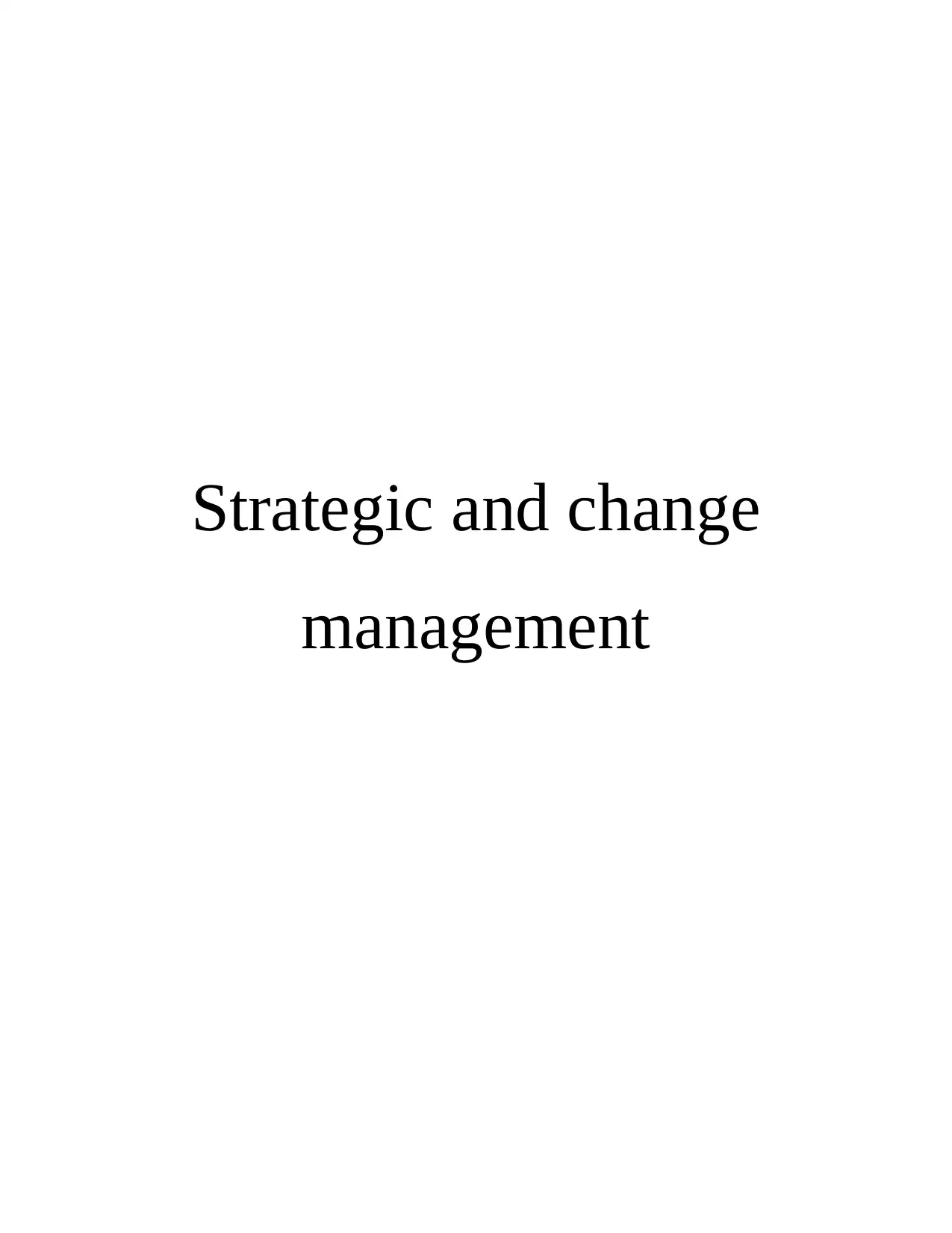
Strategic and change
management
management
Paraphrase This Document
Need a fresh take? Get an instant paraphrase of this document with our AI Paraphraser
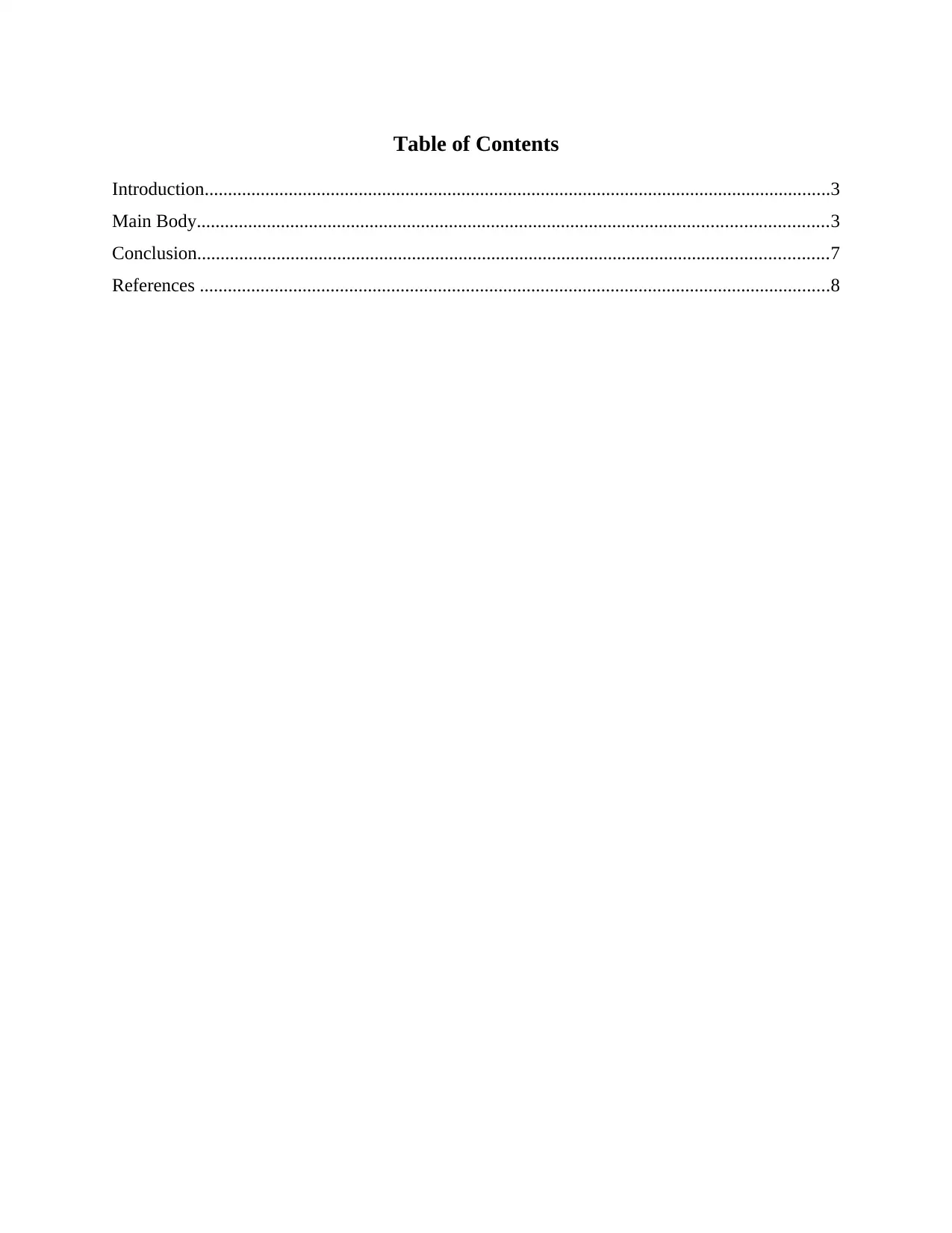
Table of Contents
Introduction......................................................................................................................................3
Main Body.......................................................................................................................................3
Conclusion.......................................................................................................................................7
References .......................................................................................................................................8
Introduction......................................................................................................................................3
Main Body.......................................................................................................................................3
Conclusion.......................................................................................................................................7
References .......................................................................................................................................8
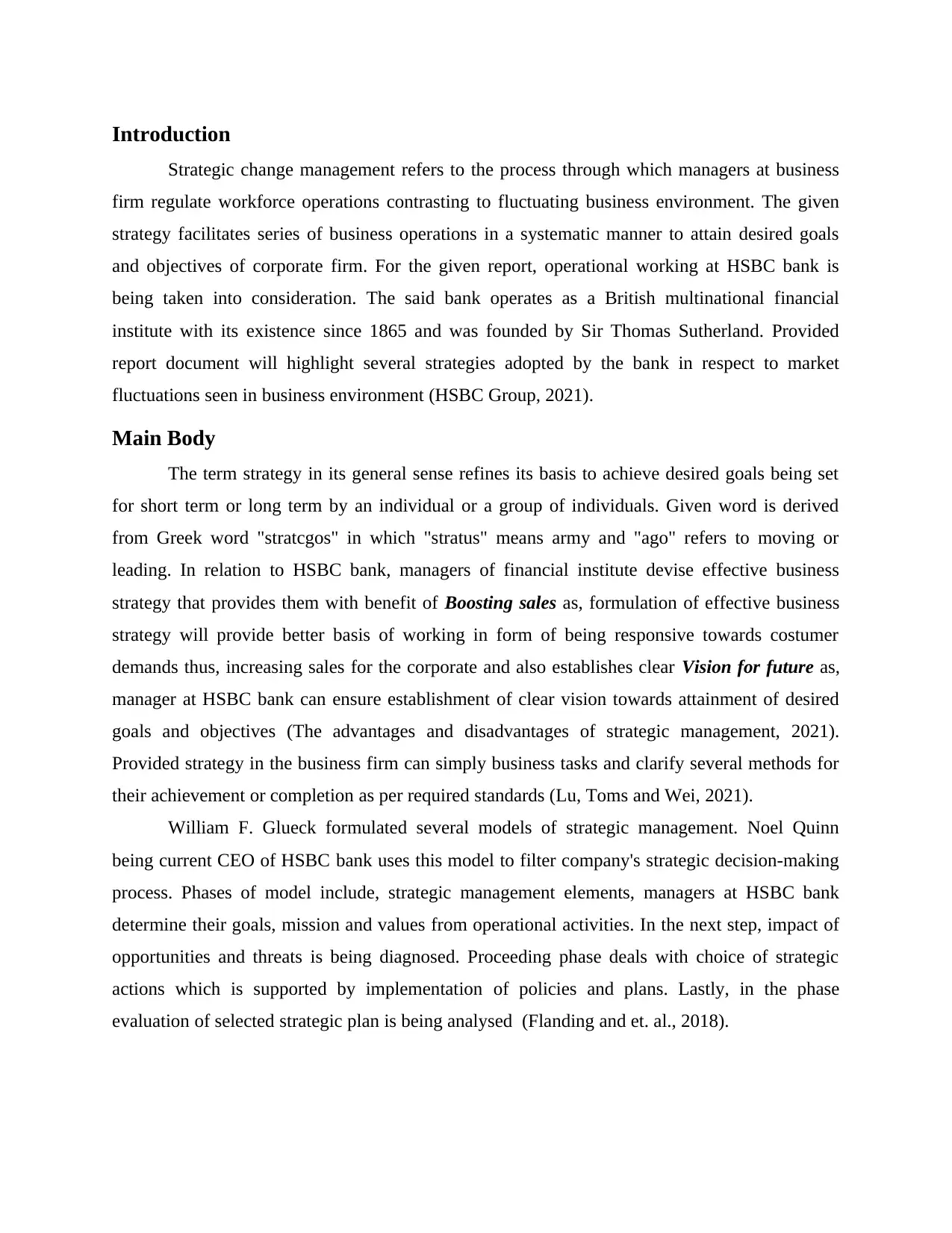
Introduction
Strategic change management refers to the process through which managers at business
firm regulate workforce operations contrasting to fluctuating business environment. The given
strategy facilitates series of business operations in a systematic manner to attain desired goals
and objectives of corporate firm. For the given report, operational working at HSBC bank is
being taken into consideration. The said bank operates as a British multinational financial
institute with its existence since 1865 and was founded by Sir Thomas Sutherland. Provided
report document will highlight several strategies adopted by the bank in respect to market
fluctuations seen in business environment (HSBC Group, 2021).
Main Body
The term strategy in its general sense refines its basis to achieve desired goals being set
for short term or long term by an individual or a group of individuals. Given word is derived
from Greek word "stratcgos" in which "stratus" means army and "ago" refers to moving or
leading. In relation to HSBC bank, managers of financial institute devise effective business
strategy that provides them with benefit of Boosting sales as, formulation of effective business
strategy will provide better basis of working in form of being responsive towards costumer
demands thus, increasing sales for the corporate and also establishes clear Vision for future as,
manager at HSBC bank can ensure establishment of clear vision towards attainment of desired
goals and objectives (The advantages and disadvantages of strategic management, 2021).
Provided strategy in the business firm can simply business tasks and clarify several methods for
their achievement or completion as per required standards (Lu, Toms and Wei, 2021).
William F. Glueck formulated several models of strategic management. Noel Quinn
being current CEO of HSBC bank uses this model to filter company's strategic decision-making
process. Phases of model include, strategic management elements, managers at HSBC bank
determine their goals, mission and values from operational activities. In the next step, impact of
opportunities and threats is being diagnosed. Proceeding phase deals with choice of strategic
actions which is supported by implementation of policies and plans. Lastly, in the phase
evaluation of selected strategic plan is being analysed (Flanding and et. al., 2018).
Strategic change management refers to the process through which managers at business
firm regulate workforce operations contrasting to fluctuating business environment. The given
strategy facilitates series of business operations in a systematic manner to attain desired goals
and objectives of corporate firm. For the given report, operational working at HSBC bank is
being taken into consideration. The said bank operates as a British multinational financial
institute with its existence since 1865 and was founded by Sir Thomas Sutherland. Provided
report document will highlight several strategies adopted by the bank in respect to market
fluctuations seen in business environment (HSBC Group, 2021).
Main Body
The term strategy in its general sense refines its basis to achieve desired goals being set
for short term or long term by an individual or a group of individuals. Given word is derived
from Greek word "stratcgos" in which "stratus" means army and "ago" refers to moving or
leading. In relation to HSBC bank, managers of financial institute devise effective business
strategy that provides them with benefit of Boosting sales as, formulation of effective business
strategy will provide better basis of working in form of being responsive towards costumer
demands thus, increasing sales for the corporate and also establishes clear Vision for future as,
manager at HSBC bank can ensure establishment of clear vision towards attainment of desired
goals and objectives (The advantages and disadvantages of strategic management, 2021).
Provided strategy in the business firm can simply business tasks and clarify several methods for
their achievement or completion as per required standards (Lu, Toms and Wei, 2021).
William F. Glueck formulated several models of strategic management. Noel Quinn
being current CEO of HSBC bank uses this model to filter company's strategic decision-making
process. Phases of model include, strategic management elements, managers at HSBC bank
determine their goals, mission and values from operational activities. In the next step, impact of
opportunities and threats is being diagnosed. Proceeding phase deals with choice of strategic
actions which is supported by implementation of policies and plans. Lastly, in the phase
evaluation of selected strategic plan is being analysed (Flanding and et. al., 2018).
⊘ This is a preview!⊘
Do you want full access?
Subscribe today to unlock all pages.

Trusted by 1+ million students worldwide
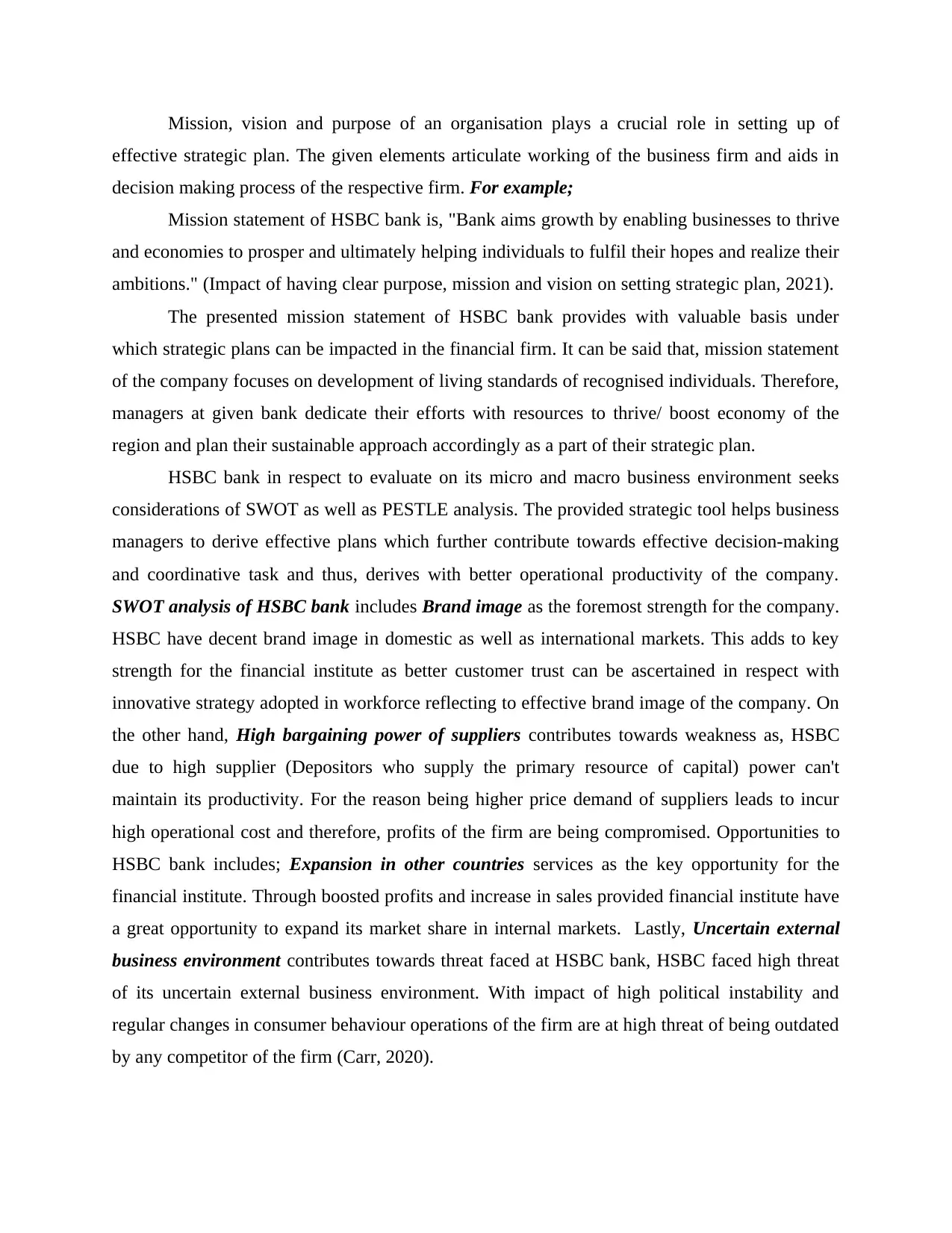
Mission, vision and purpose of an organisation plays a crucial role in setting up of
effective strategic plan. The given elements articulate working of the business firm and aids in
decision making process of the respective firm. For example;
Mission statement of HSBC bank is, "Bank aims growth by enabling businesses to thrive
and economies to prosper and ultimately helping individuals to fulfil their hopes and realize their
ambitions." (Impact of having clear purpose, mission and vision on setting strategic plan, 2021).
The presented mission statement of HSBC bank provides with valuable basis under
which strategic plans can be impacted in the financial firm. It can be said that, mission statement
of the company focuses on development of living standards of recognised individuals. Therefore,
managers at given bank dedicate their efforts with resources to thrive/ boost economy of the
region and plan their sustainable approach accordingly as a part of their strategic plan.
HSBC bank in respect to evaluate on its micro and macro business environment seeks
considerations of SWOT as well as PESTLE analysis. The provided strategic tool helps business
managers to derive effective plans which further contribute towards effective decision-making
and coordinative task and thus, derives with better operational productivity of the company.
SWOT analysis of HSBC bank includes Brand image as the foremost strength for the company.
HSBC have decent brand image in domestic as well as international markets. This adds to key
strength for the financial institute as better customer trust can be ascertained in respect with
innovative strategy adopted in workforce reflecting to effective brand image of the company. On
the other hand, High bargaining power of suppliers contributes towards weakness as, HSBC
due to high supplier (Depositors who supply the primary resource of capital) power can't
maintain its productivity. For the reason being higher price demand of suppliers leads to incur
high operational cost and therefore, profits of the firm are being compromised. Opportunities to
HSBC bank includes; Expansion in other countries services as the key opportunity for the
financial institute. Through boosted profits and increase in sales provided financial institute have
a great opportunity to expand its market share in internal markets. Lastly, Uncertain external
business environment contributes towards threat faced at HSBC bank, HSBC faced high threat
of its uncertain external business environment. With impact of high political instability and
regular changes in consumer behaviour operations of the firm are at high threat of being outdated
by any competitor of the firm (Carr, 2020).
effective strategic plan. The given elements articulate working of the business firm and aids in
decision making process of the respective firm. For example;
Mission statement of HSBC bank is, "Bank aims growth by enabling businesses to thrive
and economies to prosper and ultimately helping individuals to fulfil their hopes and realize their
ambitions." (Impact of having clear purpose, mission and vision on setting strategic plan, 2021).
The presented mission statement of HSBC bank provides with valuable basis under
which strategic plans can be impacted in the financial firm. It can be said that, mission statement
of the company focuses on development of living standards of recognised individuals. Therefore,
managers at given bank dedicate their efforts with resources to thrive/ boost economy of the
region and plan their sustainable approach accordingly as a part of their strategic plan.
HSBC bank in respect to evaluate on its micro and macro business environment seeks
considerations of SWOT as well as PESTLE analysis. The provided strategic tool helps business
managers to derive effective plans which further contribute towards effective decision-making
and coordinative task and thus, derives with better operational productivity of the company.
SWOT analysis of HSBC bank includes Brand image as the foremost strength for the company.
HSBC have decent brand image in domestic as well as international markets. This adds to key
strength for the financial institute as better customer trust can be ascertained in respect with
innovative strategy adopted in workforce reflecting to effective brand image of the company. On
the other hand, High bargaining power of suppliers contributes towards weakness as, HSBC
due to high supplier (Depositors who supply the primary resource of capital) power can't
maintain its productivity. For the reason being higher price demand of suppliers leads to incur
high operational cost and therefore, profits of the firm are being compromised. Opportunities to
HSBC bank includes; Expansion in other countries services as the key opportunity for the
financial institute. Through boosted profits and increase in sales provided financial institute have
a great opportunity to expand its market share in internal markets. Lastly, Uncertain external
business environment contributes towards threat faced at HSBC bank, HSBC faced high threat
of its uncertain external business environment. With impact of high political instability and
regular changes in consumer behaviour operations of the firm are at high threat of being outdated
by any competitor of the firm (Carr, 2020).
Paraphrase This Document
Need a fresh take? Get an instant paraphrase of this document with our AI Paraphraser
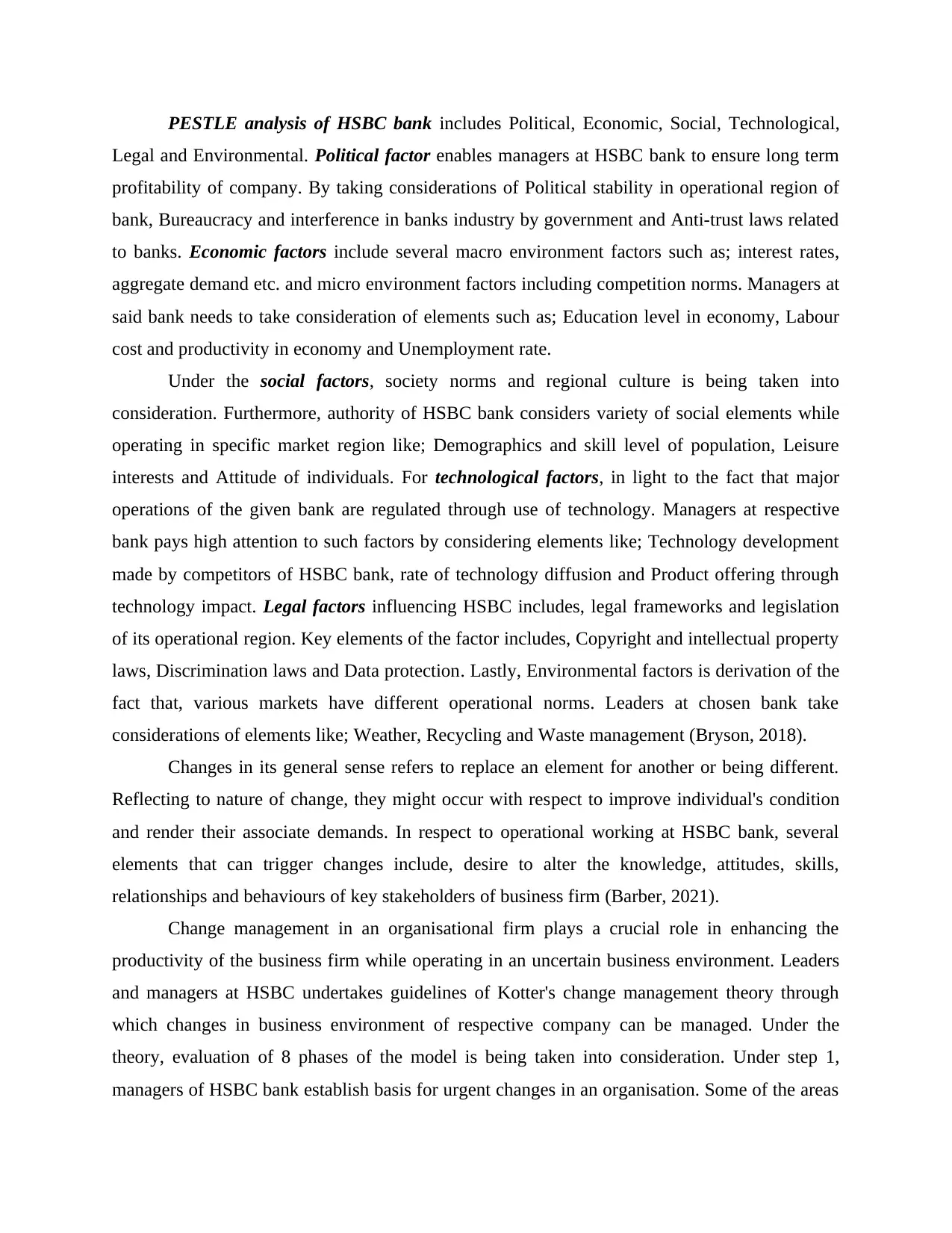
PESTLE analysis of HSBC bank includes Political, Economic, Social, Technological,
Legal and Environmental. Political factor enables managers at HSBC bank to ensure long term
profitability of company. By taking considerations of Political stability in operational region of
bank, Bureaucracy and interference in banks industry by government and Anti-trust laws related
to banks. Economic factors include several macro environment factors such as; interest rates,
aggregate demand etc. and micro environment factors including competition norms. Managers at
said bank needs to take consideration of elements such as; Education level in economy, Labour
cost and productivity in economy and Unemployment rate.
Under the social factors, society norms and regional culture is being taken into
consideration. Furthermore, authority of HSBC bank considers variety of social elements while
operating in specific market region like; Demographics and skill level of population, Leisure
interests and Attitude of individuals. For technological factors, in light to the fact that major
operations of the given bank are regulated through use of technology. Managers at respective
bank pays high attention to such factors by considering elements like; Technology development
made by competitors of HSBC bank, rate of technology diffusion and Product offering through
technology impact. Legal factors influencing HSBC includes, legal frameworks and legislation
of its operational region. Key elements of the factor includes, Copyright and intellectual property
laws, Discrimination laws and Data protection. Lastly, Environmental factors is derivation of the
fact that, various markets have different operational norms. Leaders at chosen bank take
considerations of elements like; Weather, Recycling and Waste management (Bryson, 2018).
Changes in its general sense refers to replace an element for another or being different.
Reflecting to nature of change, they might occur with respect to improve individual's condition
and render their associate demands. In respect to operational working at HSBC bank, several
elements that can trigger changes include, desire to alter the knowledge, attitudes, skills,
relationships and behaviours of key stakeholders of business firm (Barber, 2021).
Change management in an organisational firm plays a crucial role in enhancing the
productivity of the business firm while operating in an uncertain business environment. Leaders
and managers at HSBC undertakes guidelines of Kotter's change management theory through
which changes in business environment of respective company can be managed. Under the
theory, evaluation of 8 phases of the model is being taken into consideration. Under step 1,
managers of HSBC bank establish basis for urgent changes in an organisation. Some of the areas
Legal and Environmental. Political factor enables managers at HSBC bank to ensure long term
profitability of company. By taking considerations of Political stability in operational region of
bank, Bureaucracy and interference in banks industry by government and Anti-trust laws related
to banks. Economic factors include several macro environment factors such as; interest rates,
aggregate demand etc. and micro environment factors including competition norms. Managers at
said bank needs to take consideration of elements such as; Education level in economy, Labour
cost and productivity in economy and Unemployment rate.
Under the social factors, society norms and regional culture is being taken into
consideration. Furthermore, authority of HSBC bank considers variety of social elements while
operating in specific market region like; Demographics and skill level of population, Leisure
interests and Attitude of individuals. For technological factors, in light to the fact that major
operations of the given bank are regulated through use of technology. Managers at respective
bank pays high attention to such factors by considering elements like; Technology development
made by competitors of HSBC bank, rate of technology diffusion and Product offering through
technology impact. Legal factors influencing HSBC includes, legal frameworks and legislation
of its operational region. Key elements of the factor includes, Copyright and intellectual property
laws, Discrimination laws and Data protection. Lastly, Environmental factors is derivation of the
fact that, various markets have different operational norms. Leaders at chosen bank take
considerations of elements like; Weather, Recycling and Waste management (Bryson, 2018).
Changes in its general sense refers to replace an element for another or being different.
Reflecting to nature of change, they might occur with respect to improve individual's condition
and render their associate demands. In respect to operational working at HSBC bank, several
elements that can trigger changes include, desire to alter the knowledge, attitudes, skills,
relationships and behaviours of key stakeholders of business firm (Barber, 2021).
Change management in an organisational firm plays a crucial role in enhancing the
productivity of the business firm while operating in an uncertain business environment. Leaders
and managers at HSBC undertakes guidelines of Kotter's change management theory through
which changes in business environment of respective company can be managed. Under the
theory, evaluation of 8 phases of the model is being taken into consideration. Under step 1,
managers of HSBC bank establish basis for urgent changes in an organisation. Some of the areas
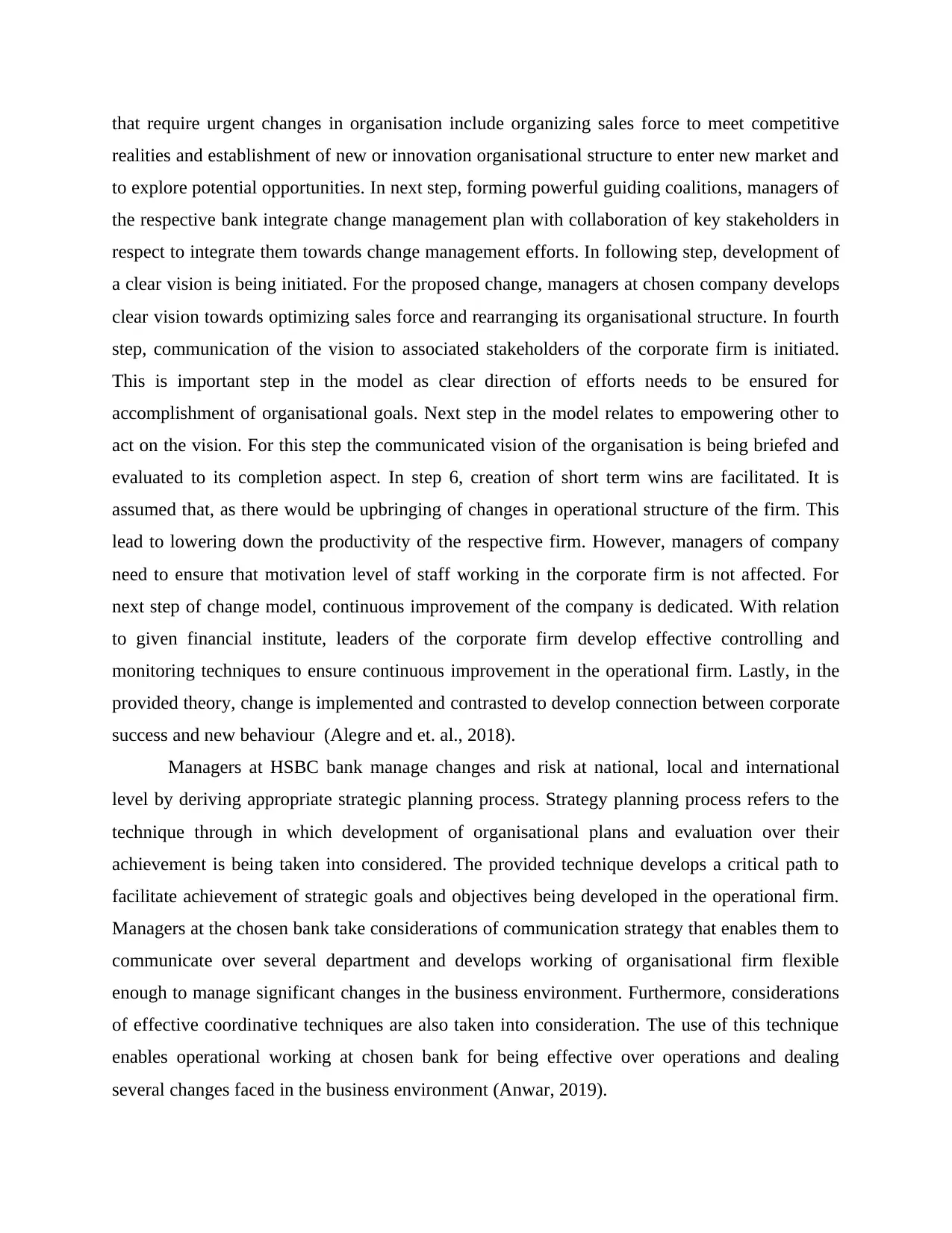
that require urgent changes in organisation include organizing sales force to meet competitive
realities and establishment of new or innovation organisational structure to enter new market and
to explore potential opportunities. In next step, forming powerful guiding coalitions, managers of
the respective bank integrate change management plan with collaboration of key stakeholders in
respect to integrate them towards change management efforts. In following step, development of
a clear vision is being initiated. For the proposed change, managers at chosen company develops
clear vision towards optimizing sales force and rearranging its organisational structure. In fourth
step, communication of the vision to associated stakeholders of the corporate firm is initiated.
This is important step in the model as clear direction of efforts needs to be ensured for
accomplishment of organisational goals. Next step in the model relates to empowering other to
act on the vision. For this step the communicated vision of the organisation is being briefed and
evaluated to its completion aspect. In step 6, creation of short term wins are facilitated. It is
assumed that, as there would be upbringing of changes in operational structure of the firm. This
lead to lowering down the productivity of the respective firm. However, managers of company
need to ensure that motivation level of staff working in the corporate firm is not affected. For
next step of change model, continuous improvement of the company is dedicated. With relation
to given financial institute, leaders of the corporate firm develop effective controlling and
monitoring techniques to ensure continuous improvement in the operational firm. Lastly, in the
provided theory, change is implemented and contrasted to develop connection between corporate
success and new behaviour (Alegre and et. al., 2018).
Managers at HSBC bank manage changes and risk at national, local and international
level by deriving appropriate strategic planning process. Strategy planning process refers to the
technique through in which development of organisational plans and evaluation over their
achievement is being taken into considered. The provided technique develops a critical path to
facilitate achievement of strategic goals and objectives being developed in the operational firm.
Managers at the chosen bank take considerations of communication strategy that enables them to
communicate over several department and develops working of organisational firm flexible
enough to manage significant changes in the business environment. Furthermore, considerations
of effective coordinative techniques are also taken into consideration. The use of this technique
enables operational working at chosen bank for being effective over operations and dealing
several changes faced in the business environment (Anwar, 2019).
realities and establishment of new or innovation organisational structure to enter new market and
to explore potential opportunities. In next step, forming powerful guiding coalitions, managers of
the respective bank integrate change management plan with collaboration of key stakeholders in
respect to integrate them towards change management efforts. In following step, development of
a clear vision is being initiated. For the proposed change, managers at chosen company develops
clear vision towards optimizing sales force and rearranging its organisational structure. In fourth
step, communication of the vision to associated stakeholders of the corporate firm is initiated.
This is important step in the model as clear direction of efforts needs to be ensured for
accomplishment of organisational goals. Next step in the model relates to empowering other to
act on the vision. For this step the communicated vision of the organisation is being briefed and
evaluated to its completion aspect. In step 6, creation of short term wins are facilitated. It is
assumed that, as there would be upbringing of changes in operational structure of the firm. This
lead to lowering down the productivity of the respective firm. However, managers of company
need to ensure that motivation level of staff working in the corporate firm is not affected. For
next step of change model, continuous improvement of the company is dedicated. With relation
to given financial institute, leaders of the corporate firm develop effective controlling and
monitoring techniques to ensure continuous improvement in the operational firm. Lastly, in the
provided theory, change is implemented and contrasted to develop connection between corporate
success and new behaviour (Alegre and et. al., 2018).
Managers at HSBC bank manage changes and risk at national, local and international
level by deriving appropriate strategic planning process. Strategy planning process refers to the
technique through in which development of organisational plans and evaluation over their
achievement is being taken into considered. The provided technique develops a critical path to
facilitate achievement of strategic goals and objectives being developed in the operational firm.
Managers at the chosen bank take considerations of communication strategy that enables them to
communicate over several department and develops working of organisational firm flexible
enough to manage significant changes in the business environment. Furthermore, considerations
of effective coordinative techniques are also taken into consideration. The use of this technique
enables operational working at chosen bank for being effective over operations and dealing
several changes faced in the business environment (Anwar, 2019).
⊘ This is a preview!⊘
Do you want full access?
Subscribe today to unlock all pages.

Trusted by 1+ million students worldwide
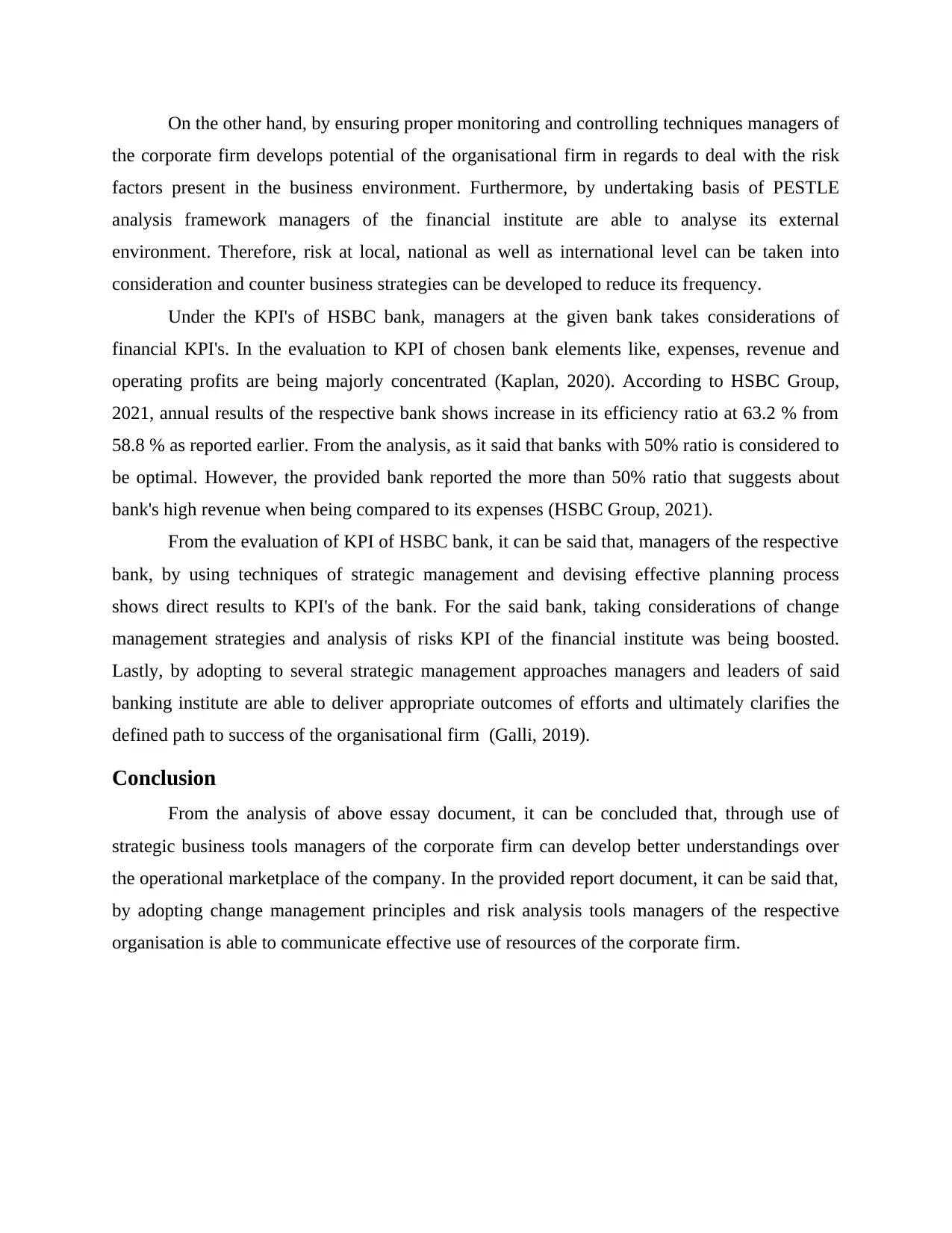
On the other hand, by ensuring proper monitoring and controlling techniques managers of
the corporate firm develops potential of the organisational firm in regards to deal with the risk
factors present in the business environment. Furthermore, by undertaking basis of PESTLE
analysis framework managers of the financial institute are able to analyse its external
environment. Therefore, risk at local, national as well as international level can be taken into
consideration and counter business strategies can be developed to reduce its frequency.
Under the KPI's of HSBC bank, managers at the given bank takes considerations of
financial KPI's. In the evaluation to KPI of chosen bank elements like, expenses, revenue and
operating profits are being majorly concentrated (Kaplan, 2020). According to HSBC Group,
2021, annual results of the respective bank shows increase in its efficiency ratio at 63.2 % from
58.8 % as reported earlier. From the analysis, as it said that banks with 50% ratio is considered to
be optimal. However, the provided bank reported the more than 50% ratio that suggests about
bank's high revenue when being compared to its expenses (HSBC Group, 2021).
From the evaluation of KPI of HSBC bank, it can be said that, managers of the respective
bank, by using techniques of strategic management and devising effective planning process
shows direct results to KPI's of the bank. For the said bank, taking considerations of change
management strategies and analysis of risks KPI of the financial institute was being boosted.
Lastly, by adopting to several strategic management approaches managers and leaders of said
banking institute are able to deliver appropriate outcomes of efforts and ultimately clarifies the
defined path to success of the organisational firm (Galli, 2019).
Conclusion
From the analysis of above essay document, it can be concluded that, through use of
strategic business tools managers of the corporate firm can develop better understandings over
the operational marketplace of the company. In the provided report document, it can be said that,
by adopting change management principles and risk analysis tools managers of the respective
organisation is able to communicate effective use of resources of the corporate firm.
the corporate firm develops potential of the organisational firm in regards to deal with the risk
factors present in the business environment. Furthermore, by undertaking basis of PESTLE
analysis framework managers of the financial institute are able to analyse its external
environment. Therefore, risk at local, national as well as international level can be taken into
consideration and counter business strategies can be developed to reduce its frequency.
Under the KPI's of HSBC bank, managers at the given bank takes considerations of
financial KPI's. In the evaluation to KPI of chosen bank elements like, expenses, revenue and
operating profits are being majorly concentrated (Kaplan, 2020). According to HSBC Group,
2021, annual results of the respective bank shows increase in its efficiency ratio at 63.2 % from
58.8 % as reported earlier. From the analysis, as it said that banks with 50% ratio is considered to
be optimal. However, the provided bank reported the more than 50% ratio that suggests about
bank's high revenue when being compared to its expenses (HSBC Group, 2021).
From the evaluation of KPI of HSBC bank, it can be said that, managers of the respective
bank, by using techniques of strategic management and devising effective planning process
shows direct results to KPI's of the bank. For the said bank, taking considerations of change
management strategies and analysis of risks KPI of the financial institute was being boosted.
Lastly, by adopting to several strategic management approaches managers and leaders of said
banking institute are able to deliver appropriate outcomes of efforts and ultimately clarifies the
defined path to success of the organisational firm (Galli, 2019).
Conclusion
From the analysis of above essay document, it can be concluded that, through use of
strategic business tools managers of the corporate firm can develop better understandings over
the operational marketplace of the company. In the provided report document, it can be said that,
by adopting change management principles and risk analysis tools managers of the respective
organisation is able to communicate effective use of resources of the corporate firm.
Paraphrase This Document
Need a fresh take? Get an instant paraphrase of this document with our AI Paraphraser
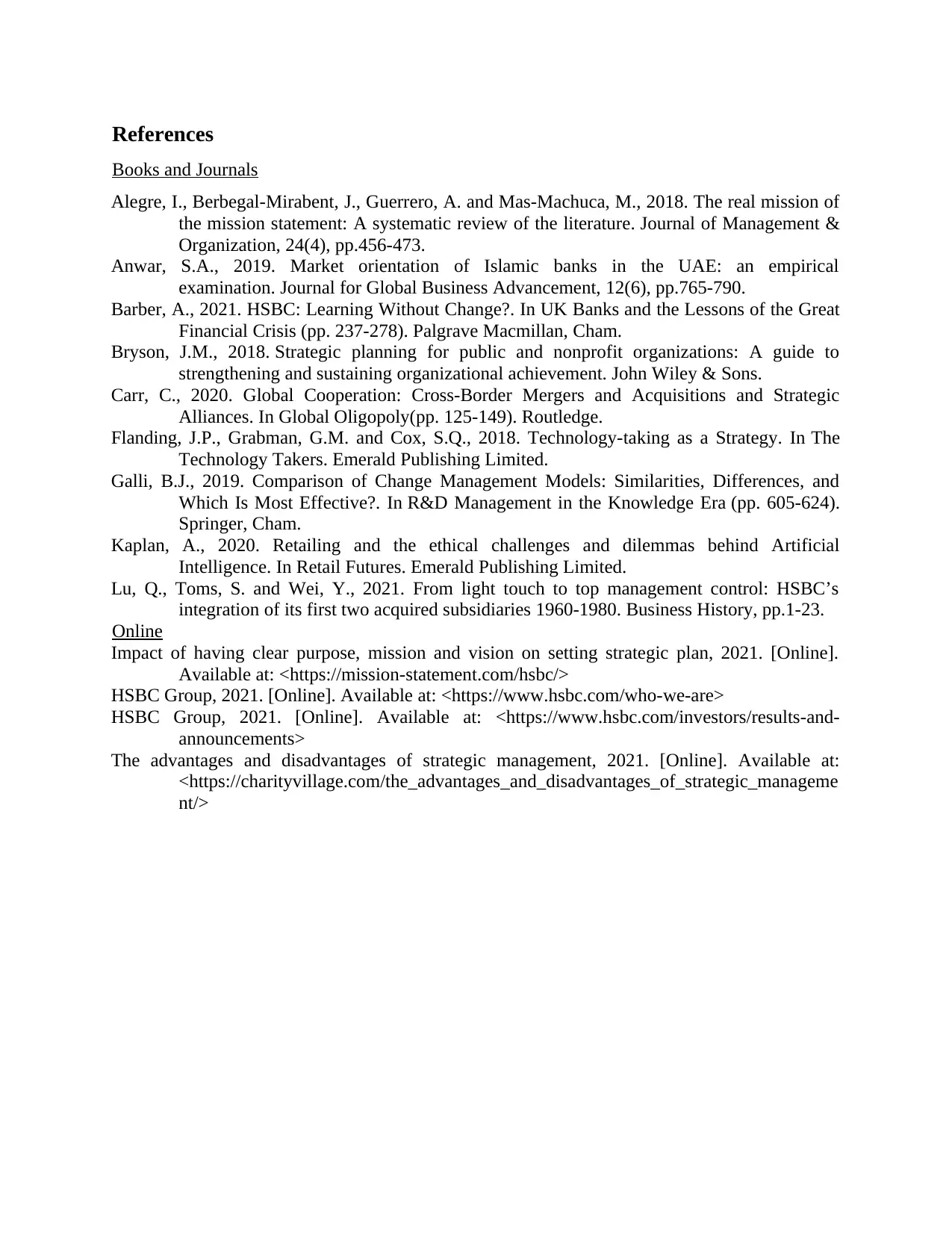
References
Books and Journals
Alegre, I., Berbegal-Mirabent, J., Guerrero, A. and Mas-Machuca, M., 2018. The real mission of
the mission statement: A systematic review of the literature. Journal of Management &
Organization, 24(4), pp.456-473.
Anwar, S.A., 2019. Market orientation of Islamic banks in the UAE: an empirical
examination. Journal for Global Business Advancement, 12(6), pp.765-790.
Barber, A., 2021. HSBC: Learning Without Change?. In UK Banks and the Lessons of the Great
Financial Crisis (pp. 237-278). Palgrave Macmillan, Cham.
Bryson, J.M., 2018. Strategic planning for public and nonprofit organizations: A guide to
strengthening and sustaining organizational achievement. John Wiley & Sons.
Carr, C., 2020. Global Cooperation: Cross-Border Mergers and Acquisitions and Strategic
Alliances. In Global Oligopoly(pp. 125-149). Routledge.
Flanding, J.P., Grabman, G.M. and Cox, S.Q., 2018. Technology-taking as a Strategy. In The
Technology Takers. Emerald Publishing Limited.
Galli, B.J., 2019. Comparison of Change Management Models: Similarities, Differences, and
Which Is Most Effective?. In R&D Management in the Knowledge Era (pp. 605-624).
Springer, Cham.
Kaplan, A., 2020. Retailing and the ethical challenges and dilemmas behind Artificial
Intelligence. In Retail Futures. Emerald Publishing Limited.
Lu, Q., Toms, S. and Wei, Y., 2021. From light touch to top management control: HSBC’s
integration of its first two acquired subsidiaries 1960-1980. Business History, pp.1-23.
Online
Impact of having clear purpose, mission and vision on setting strategic plan, 2021. [Online].
Available at: <https://mission-statement.com/hsbc/>
HSBC Group, 2021. [Online]. Available at: <https://www.hsbc.com/who-we-are>
HSBC Group, 2021. [Online]. Available at: <https://www.hsbc.com/investors/results-and-
announcements>
The advantages and disadvantages of strategic management, 2021. [Online]. Available at:
<https://charityvillage.com/the_advantages_and_disadvantages_of_strategic_manageme
nt/>
Books and Journals
Alegre, I., Berbegal-Mirabent, J., Guerrero, A. and Mas-Machuca, M., 2018. The real mission of
the mission statement: A systematic review of the literature. Journal of Management &
Organization, 24(4), pp.456-473.
Anwar, S.A., 2019. Market orientation of Islamic banks in the UAE: an empirical
examination. Journal for Global Business Advancement, 12(6), pp.765-790.
Barber, A., 2021. HSBC: Learning Without Change?. In UK Banks and the Lessons of the Great
Financial Crisis (pp. 237-278). Palgrave Macmillan, Cham.
Bryson, J.M., 2018. Strategic planning for public and nonprofit organizations: A guide to
strengthening and sustaining organizational achievement. John Wiley & Sons.
Carr, C., 2020. Global Cooperation: Cross-Border Mergers and Acquisitions and Strategic
Alliances. In Global Oligopoly(pp. 125-149). Routledge.
Flanding, J.P., Grabman, G.M. and Cox, S.Q., 2018. Technology-taking as a Strategy. In The
Technology Takers. Emerald Publishing Limited.
Galli, B.J., 2019. Comparison of Change Management Models: Similarities, Differences, and
Which Is Most Effective?. In R&D Management in the Knowledge Era (pp. 605-624).
Springer, Cham.
Kaplan, A., 2020. Retailing and the ethical challenges and dilemmas behind Artificial
Intelligence. In Retail Futures. Emerald Publishing Limited.
Lu, Q., Toms, S. and Wei, Y., 2021. From light touch to top management control: HSBC’s
integration of its first two acquired subsidiaries 1960-1980. Business History, pp.1-23.
Online
Impact of having clear purpose, mission and vision on setting strategic plan, 2021. [Online].
Available at: <https://mission-statement.com/hsbc/>
HSBC Group, 2021. [Online]. Available at: <https://www.hsbc.com/who-we-are>
HSBC Group, 2021. [Online]. Available at: <https://www.hsbc.com/investors/results-and-
announcements>
The advantages and disadvantages of strategic management, 2021. [Online]. Available at:
<https://charityvillage.com/the_advantages_and_disadvantages_of_strategic_manageme
nt/>
1 out of 8
Related Documents
Your All-in-One AI-Powered Toolkit for Academic Success.
+13062052269
info@desklib.com
Available 24*7 on WhatsApp / Email
![[object Object]](/_next/static/media/star-bottom.7253800d.svg)
Unlock your academic potential
Copyright © 2020–2025 A2Z Services. All Rights Reserved. Developed and managed by ZUCOL.




